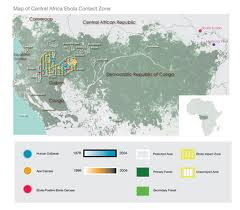Ebola is one of the most powerful viral diseases known to humankind, causing death of 50-90% of those infected. The disease has its origins in the jungles of Africa and Asia. Several different forms of the virus have been identified and are discussed below.
The mode of transmission
• Ebola is spread by direct contact with blood, secretions or organs of infected persons.
• The virus can spread by contact with dead or sick chimpanzees.
• health workers were often infected patients. In the 1976 outbreak in Zaire, Ebola-infected everyone with syringes and needles died.
Incubation: 2 to 21 days.
.jpg) Symptoms: Ebola is characterized by sudden onset of a severe fever, fatigue, muscle aches, headaches and neck. These are followed by vomiting, diarrhea, urticaria, renal and liver, internal and external bleeding.
Symptoms: Ebola is characterized by sudden onset of a severe fever, fatigue, muscle aches, headaches and neck. These are followed by vomiting, diarrhea, urticaria, renal and liver, internal and external bleeding..jpg) Diagnosis: is made in specialized laboratories by detection of specific genes of the virus. These tests have a very high degree of danger and are made only in maximum safety conditions.
Diagnosis: is made in specialized laboratories by detection of specific genes of the virus. These tests have a very high degree of danger and are made only in maximum safety conditions.
Treatment
• No specific treatment or vaccine for Ebola.
• Severe cases require intensive care because patients are dehydrated very quickly and need to receive fluids intravenously.
• Experimental studies on animals have not had the desired effect against the virus for long periods.
Quarantine
• suspected cases were isolated from other patients and should be kept in strict conditions of safety.
• All hospital staff should be notified of the nature of disease and mode of transmission. Procedures with high risk of infection as a connecting intravenous lines and handling blood, secretions and instruments should be used carefully.
• Patients who die from the virus should be buried or cremated as soon as possible.

No comments:
Post a Comment